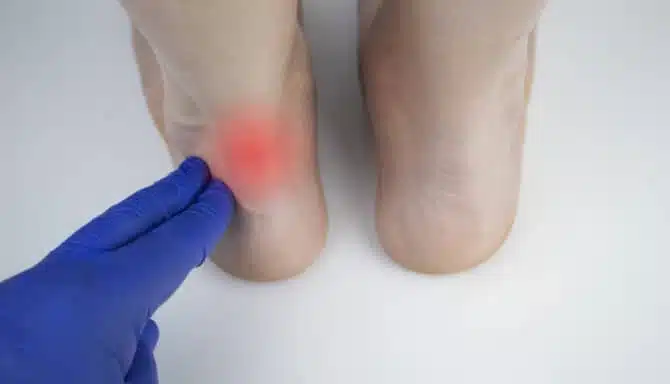Bunions can target anyone, but they are more common in older women due to factors like foot anatomy and footwear choices. Luckily, there are ways you can prevent and manage bunions to the best of your ability, especially if you work with a chiropodist or podiatrist. Let’s explore everything there is to know about bunions, including the reasons why older women are more at risk for developing bunions.
This article will answer:
- What are bunions?
- Who’s at risk?
- Why are older women at risk?
- How do you treat bunions?
- How do you prevent bunions?
- Do I need bunion surgery?
What Are Bunions?

Bunions are toe deformities in which the big toe shifts towards the second toe at an angle. This causes the joint at the base of the big toe (the first metatarsophalangeal joint, or MTP joint) to protrude outwards, forming a bump that can become swollen, tender, and uncomfortable. The MTP joint bears a lot of pressure while walking or standing, which can worsen the bunion over time. As the condition progresses, people with bunions often experience pain and difficulty wearing certain shoes.
Another related condition common in older women is hallux rigidus, where arthritis or stiffness affects the big toe joint, limiting its movement. Hallux rigidus may not cause the same protrusion as bunions (it’s usually seen on top of the joint), but it can still lead to pain and difficulty moving the toe. Many people may think that hallux rigidus is the same as a bunion, but they are different – the scientific term for bunions is hallux (abducto) valgus.
Causes of Bunions: Who’s at Risk?
While bunions aren’t typically caused by one thing alone, there are several risk factors that contribute to the likelihood of developing bunions. All these risk factors either weaken or cause extra strain on the MTP joint. These include:
- Age: Bunions can start to form as young as 30, but they are commonly associated with seniors and become more debilitating and noticeable with age. Some studies suggest 1 in 3 people over the age of 65 have a pronounced bunion, many of them being women.
- Genetics: Bunions are partly genetic because foot shape and structure, often inherited traits, can increase the risk of developing them. People with certain foot shapes—particularly flat feet—are more prone to bunions because this structure creates imbalanced pressure on the big toe joint.
- Wearing ill-fitting footwear: Frequently wearing narrow, tight, or high-heeled shoes that squeeze the toes can push the big toe inward, contributing to bunion formation. Pointed, unstready high-heeled shoes with very thin heels (like stilettos) are extra risky.
- Having Rheumatoid arthritis: Conditions that affect joint health and increase inflammation, such as rheumatoid arthritis, can lead to bunion formation.
- Previous foot injuries: Tendon tears, or having broken a bone in the past, can increase risk.
Why are Older Women at Risk?
Senior women are more likely than other groups to experience painful bunions for a handful of reasons:
- Older people are more susceptible to joint-wear-and-tear and other foot conditions like osteoarthritis (which is caused by wear-and-tear on the joints, and is commonly associated with age). And pre-existing joint issues make you more prone to bunions.
- Many older women have a history of wearing ill-fitting shoes with cramped toe boxes and unsteady high heels for decades. Tight shoes and high heels put extra strain and pressure on the MTP joint. The collective effects of this pressure accumulate over time and, compounded with other age-related risk factors, can accelerate, contribute to or exacerbate the formation of bunions.
- Women may have weaker connective tissue in their feet. This will reduce the big toe’s ability to withstand the force and pressure of our movement.
- Bunions can worsen during menopause due to hormonal changes loosening ligaments and flattening the feet, making them more vulnerable. This can also happen during pregnancy and have long-lasting effects on the feet. Menopause can also affect bone density, which can accelerate joint degeneration, weaken joints, and therefore aggravate bunions.
Bunions in Older Women: Treatment
If you are struggling with bunion pain, visiting a foot specialist, like a chiropodist or podiatrist, at your local foot clinic can help. There are many solutions available that target the foot pain and mobility issues associated with bunions, while decreasing pressure on the big toe joint. While bunions cannot be reversed (without surgery), by strengthening your feet and reducing pressure on the big toe, you can manage the bunion growth so that it doesn’t get worse.
Bunion Exercises and Stretches
A chiropodist or podiatrist may suggest some bunion exercises and stretches. These are great for both prevention and treatment, mostly target the toes, are easy to memorize, and accommodate seniors. The exercises may feel awkward at first, but you’ll get used to them in no time.
Here are five easy-to-learn exercises you can incorporate into your daily routine to help manage bunion discomfort:
Toe Circles
Grip your big toe and move it in circular motions to maintain joint mobility. Do 10 circles in each direction per foot.
Toe Stretches
Use your fingers to press your big toe down and hold for 30 seconds, then stretch it in the opposite direction for another 30 seconds. Repeat 5 times on each foot.
Towel Grip and Pull
Place a towel on the floor and use your toes to scrunch and pull it toward you. This helps strengthen the small muscles in your feet.
Toe Curls and Spreads
Curl your toes down tightly, hold for a few seconds, then spread them wide. Repeat this motion 10 times per foot to improve flexibility and strength.
Toe Resistance Exercises
Use your fingers to apply light pressure against your big toe in various directions, pressing up, down, and sideways. Hold each for 10 seconds. Repeat 5 times on each foot.
You can also wrap a resistance band around your big toes and then spread your feet apart while keeping your heels planted, as shown in the video above.
Other bunion treatment options provided by a foot specialist include:
Footwear recommendations: We’ll get more into this later, but opt for shoes with a wide toe box that give your toes enough room. You should also look for features like cushioned insoles and good arch support to reduce pressure on the bunion.
Custom orthotics: A foot specialist will assess your feet and design custom orthotic insoles tailored to your feet. Orthotics work by reducing pressure and force on the big toe joint, which will then reduce bunion pain and help prevent the bunion from getting worse. Custom orthotics for bunions provide support and help realign the foot, redistributing pressure away from the bunion. You can then put the orthotics into your footwear and go about your daily activities with less pressure on the big toe.
Shockwave therapy: This treatment uses powerful acoustic pulses to reduce pain in the affected area by increasing blood flow and triggering a process that helps the body heal injured tissue. While shockwave therapy doesn’t target the bunion itself, it helps with the tight muscles and ligaments around the bunion, which reduces pain and pressure on the joint.
Bunion devices: These devices help realign the toes to varying degrees. Silicone toe separators are great for when you’re walking around at home, whereas ultra-thin bunion aligners fit comfortably in most footwear and are great for athletic people. For more significant correction, rigid bunion splints help stabilize the joint.
Therapeutic taping: A foot specialist can apply therapeutic tape to provide support, reduce pain, and help correct the alignment of the bunion, allowing for better mobility.
Shoe stretching: If your shoes are too tight, professional shoe stretching can help relieve pressure on the bunion, making footwear more comfortable.
Best Bunion Prevention Tips
There isn’t much you can do about your genetics or age, but you can be mindful about other lifestyle factors to manage bunion formation.
Wearing the Right Footwear
The best preventative measure you can take to try and avoid bunions is wearing the right shoes for your feet.
You should be especially vigilant about finding shoes that are wide enough for your toes to rest comfortably and wiggle without crowding and overlapping. Ideally, your shoes need between ⅜” to ½” of space between the end of your longest toe and the front of the shoe. You can try an at-home test to see how wide your feet really are before visiting your Toronto foot clinic for a shoe fitting that will help you find the perfect fit.
Toe space is the biggest factor for bunion prevention, but there are many other things to consider when finding the right shoes. Check out the best footwear for healthy feet to learn what else you should look out for.
Try to avoid high heels, only wearing them for special occasions. Even then, opt for healthy heel options. Heels shouldn’t be too high or too thin—look for a block, shorter heel or wedges instead. Your shoes also shouldn’t be severely pointed and squish your toes together.
Additional Bunion Prevention Tips:
- Regular exercise and a good fitness regimen will help keep your muscles strong. Strong muscles reduce strain on the joints, which will then make you less susceptible to joint degeneration and wear-and-tear as you age. In addition, a healthy conditioned lower body and core helps with alignment and weight-bearing, meaning your big toe won’t need to work as hard when you move around.
- Since having a previous injury can be a risk factor, practice healthy foot injury prevention and FALL prevention.
- If you notice early signs of bunion formation, such as redness or swelling around the big toe joint, consult a foot specialist promptly.
- You should also consult a foot specialist if you have any family members with bunions, notice any issues with your alignment, have flat feet, or any other biomechanical concerns, as faulty biomechanics increase strain on the big toe joint.
- Excess weight can put additional pressure on your feet, increasing the risk of bunion development. Maintaining a healthy weight can help reduce this strain.
Do I Need Bunion Surgery?
Seniors may be more likely to seek a surgical consult after living with bunions for a longer period than young people, and trying other non-invasive treatment options with a podiatrist or chiropodist first.
That said, these days there are more non-surgical treatment options than ever before and your chances of needing a surgery are still somewhat low. Surgeries are typically recommended for older women or any individual who experiences significant pain or functional limitations; surgeries are not usually performed solely for cosmetic reasons.
At FeetFirstClinic you will start with a full foot assessment to determine the severity of your condition and your foot specialist will form a treatment plan with you.











